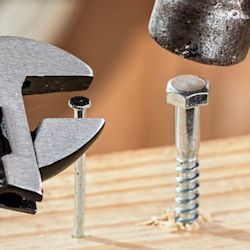Ergonomics
Some tools are advertised as "ergonomic" or designed with ergonomic features.

A tool becomes "ergonomic" only when it fits the task you are performing, and it fits your hand without causing awkward postures, harmful contact pressures, or other safety and health risks.
If you use a tool that does not fit your hand, not fit the task or is not used as designed, you're more likely to damage the tool or develop an injury, such as carpal tunnel syndrome, tendonitis, or muscle strain.
These injuries do not happen because of a single event, such as a fall. Instead, they result from repetitive movements that are performed over time or for a long period.
Unsafe practices may result in damage to muscles, tendons, nerves, ligaments, joints, cartilage, spinal discs, or blood vessels. Below are some ergonomic issues to consider when using hand and power tools.
Knowledge Check Choose the best answer for the question.
1-3. What is more likely if a tool does not fit your hand or is not used as designed?
You forgot to answer the question!
